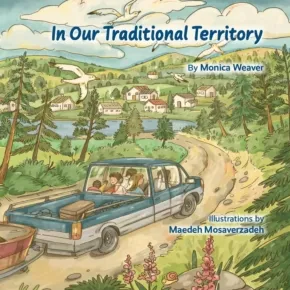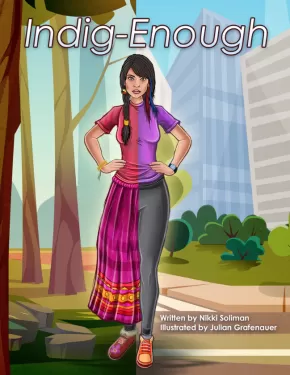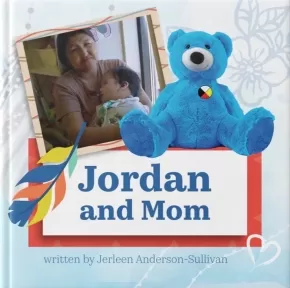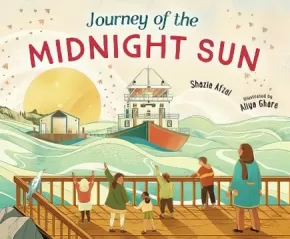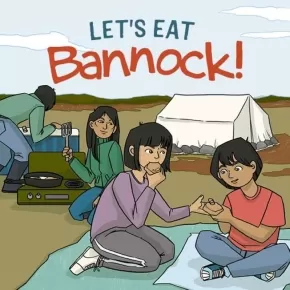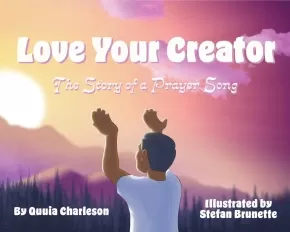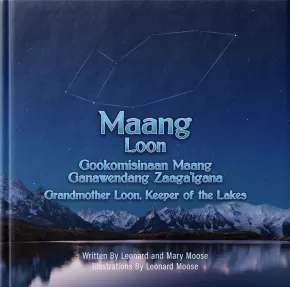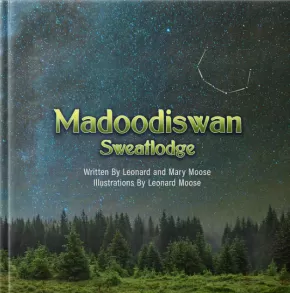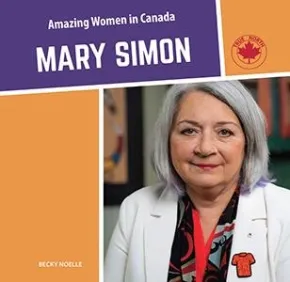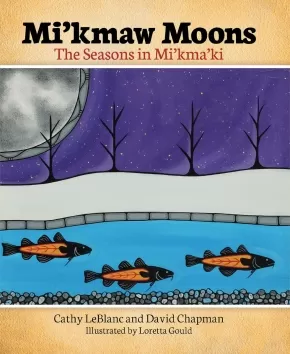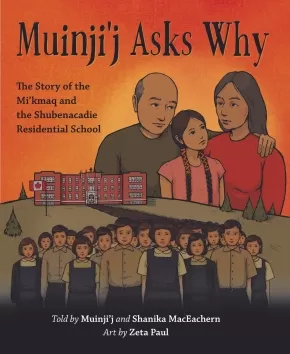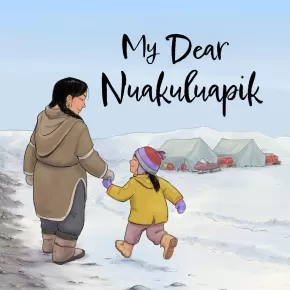
Indigenous Peoples in Canada
91
-
105
of
326 Results;
Sort By
Go To
of 22
I Wish You Were Here
 $16.95
$16.95

Format:
Hardcover
Text Content Territories:
Indigenous Canadian; First Nations; Tsimshian (Ts'msysen); Haida;
ISBN / Barcode: 9781771745727
Synopsis:
Synopsis:
Dear Jean,
I had a substitute teacher recently. He stood up for a girl wearing a cedar hat when she was told to take it off by the vice-principal…
Even though Jean and Michael come from different cultural backgrounds and live far apart, they are best friends. To keep in touch, they write letters. Read their letters to discover what Jean and Michael do when they see and experience racial prejudice in their communities.
I Wish You Were Here is based on the authors' childhood experiences as pen pals in Haida Gwaii and Terrace in northern British Columbia. The book explores themes of friendship, culture, family, and community. It also addresses some tough issues, such as racism and intolerance, and explores ways to respond proactively. Included are resources and discussion questions to encourage further learning and reflection.
Reviews
“This lovely book explores healthy strategies for addressing racism and discrimination, including ceremonies, art, and intercultural allies. It is necessary reading for fostering the reconciliation and Indigenous resurgence that is imperative for our collective growth and enlightenment.” – Terri-Lynn Williams-Davidson, musician, author, activist, artist, and lawyer
“This book helps us to empower our children and each other in the important work of recognizing, talking about, and working through acts of racism.” – Severn Cullis-Suzuki, lifelong activist for intergenerational justice
Educator Information
Recommended for grades 3 to 7.
This middle-grade picture book includes discussion questions, a glossary, and additional resources for further learning and reflection.
Curriculum Connections & Keywords: Reconciliation, Indigenous Education, Social Awareness and Responsibility, Social Studies, Allyship, Racism, Anti-Racism, Discrimination, Social Justice, Racial Injustice, Haida, Haida Gwaii, Gwaii Haanas National Park, Tsimshian, Terrace, Letter Writing, Pen Pals, Friendship, Diversity, Child Empowerment, Advocacy, Inclusivity.
This book provides readers the opportunity to look at racism and discrimination through two different cultural lenses. It's a teaching tool to initiate conversations about issues such as racism, discrimination, and reconciliation.
In the video below, Erica Jean Reid Gidin Jaad shares how to pronounce Haida and Tsimshian words in I Wish You Were Here.
Additional Information
32 Pages | 6.5" x 9.5" | Hardcover | ISBN: 9781771745727
In Our Traditional Territory
$16.95
Artists:
Format:
Paperback
Text Content Territories:
Indigenous Canadian; First Nations; Dene; Dakelh (Carrier); Lake Babine Nation ;
ISBN / Barcode: 9781777894719
Synopsis:
Synopsis:
On the river, beaver smacks his tail, the salmon swim, and a family pull in the catch. As a member of her community, six-year-old Monica participates in the traditional salmon harvest among the picturesque scenery, cold mornings, warm fires, and extended family.
Educator Information
Recommended for kindergarten to grade 3.
This book is available in French: Dans Notre Territoire Traditionnel.
Additional Information
36 pages | 8.25" x 8.25" | Paperback
Indig-Enough
$22.99
Artists:
Format:
Paperback
ISBN / Barcode: 9781990297427
Synopsis:
Synopsis:
Indig-Enough is a rhyming story that captures the author's journey in navigating and embracing her indigeneity, honouring her roots, and walking tall towards the future. This book can help guide young people in the exploration and the awareness of identity and intersectionality which can sometimes make it difficult to fit in and find their place.
Educator Information
Recommended by publisher for grades 3 to 7.
Additional Information
16 Pages
Inuunira: My Story of Survival
$19.95
Artists:
Format:
Hardcover
Text Content Territories:
Indigenous Canadian; Inuit;
ISBN / Barcode: 9781772274301
Synopsis:
Synopsis:
In this harrowing survival story, Brian Koonoo takes off on a hunting trip in Canada’s Arctic. After his snowmobile breaks down, his GPS loses signal, and his camping fuel runs low, he is left alone to survive for seven days. Inuunira is an Inuktitut term that means "how I'm alive," and this account shows exactly how Brian managed to stay alive. He experiences close encounters with planes, blizzards, and hunger, all while much of his gear is lost. Walking 60 kilometres in search of safety, he uses the knowledge his father and Elders taught him—modern and traditional means of navigation, finding water, making shelters, and keeping his spirits up—to continue on. With photos, illustrations, and diagrams throughout, readers are sure to be inspired by this story of strong will and hope.
Additional Information
37 pages | 6.75" x 9.50" | Hardcover
Jordan and Mom
$14.99
Format:
Paperback
Text Content Territories:
Indigenous Canadian; First Nations; Cree (Nehiyawak); Swampy Cree ; Norway House Cree Nation;
Grade Levels: 8;
ISBN / Barcode: 9781990297533
Synopsis:
Synopsis:
Jerleen Sullivan Anderson from Norway House Cree Nation shares the story of her brother Jordan River Anderson and their Mom Virgina Anderson in her book Jordan and Mom.
Jerleen writes this book so that we can remember Jordan and the way he was treated as a First Nations child, with his serious health condition, by the governments of Manitoba and Canada. It is a book for us to learn and understand how Jordan’s Principle came about and that Jordan had a Mom and family who loved him dearly.
Educator Information
The publisher recommends this picture book for grades seven, eight, and nine.
Keywords / Themes: Jordan's Principle; Health; Family.
Additional Information
24 Pages | Paperback
Journey of the Midnight Sun
$21.95
Artists:
Format:
Hardcover
Text Content Territories:
Indigenous Canadian; First Nations; Dene; Dinjii Zhuh (Gwich'in);
Grade Levels: Preschool; Kindergarten;
ISBN / Barcode: 9781459827608
Synopsis:
Synopsis:
This is the true story of the journey of the Midnight Sun Mosque.
In 2010 a Winnipeg-based charity raised funds to build and ship a mosque to Inuvik, one of the most northern towns in Canada’s Arctic. A small but growing Muslim community there had been using a cramped trailer for their services, but there just wasn't enough space. The mosque travelled over 4,000 kilometers on a journey fraught with poor weather, incomplete bridges, narrow roads, low traffic wires and a deadline to get on the last barge heading up the Mackenzie River before the first winter freeze. But it made it just in time and is now one of the most northern mosques in the world.
This beautiful picture book reminds us that the collective dream of fostering a multicultural and tolerant Canada exists and that people of all backgrounds will come together to build bridges and overcome obstacles for the greater good of their neighbors.
Reviews
"Roman Catholic clerics and Gwich'in First Nations elders are present at the official opening of the new mosque. A short introduction and author's note provide additional details for consideration and discussion." - Kirkus Reviews
A simple, celebratory story of community collaboration and religious tolerance.
Educator Information
Recommended for ages 3 to 5.
Additional Information
32 pages | 10.75" x 8.75" | Hardcover
Let's Eat Bannock! - Nunavummi Reading Series (6 in stock, in Reprint)
$9.95
Format:
Paperback
ISBN / Barcode: 9781774502815
Synopsis:
Synopsis:
Learn all about this delicious treat! Bannock is enjoyed by people across Nunavut. Many families have their own recipes that have been passed down for generations. This book provides information about bannock, its history, and how it is made.
Educator & Series Information
This book is part of the Nunavummi Reading Series, a Nunavut-developed series that supports literacy learning while teaching readers about the people, traditions, and environment of the Canadian Arctic. It is a Level 10 book in the series.
Nunavummi Reading Series books have also been officially levelled using the Fountas & Pinnell Text Level Gradient™ Levelling System. This book's F&P Level is L.
Recommended for ages 6 to 8.
Additional Information
24 pages | 8.00" x 8.00" | Paperback
Love Your Creator: The Story of a Prayer Song
$20.95
Artists:
Format:
Paperback
Text Content Territories:
Indigenous Canadian; First Nations; Nuu-chah-nulth (Nootka); Hesquiaht;
ISBN / Barcode: 9781777894726
Synopsis:
Synopsis:
This is the true story behind a song that was once a hymn remembered from residential school. With the help of his family and community, especially the determination of his son, and encouraging words of his Grandmother, Knowledge Keeper Quuia Charleson (Nuu-Chah-Nulth), has reclaimed Love Your Creator and continues to share both the song and its story through oral tradition at events and on travels. Engaging illustrations by Stefan Brunette passionately portray the people and events in this exciting picture book for all ages. Discover the story and learn the strength of a song.
Educator Information
Recommended for ages 5 to 12.
This book is available in French: Aime ton Créateur: L'histoire d'une chanson de prière.
Additional Information
36 pages | 10.00" x 8.00" | Paperback
Maang/Loon: Gookomisinaan Maang Genawendang Zaaga'iganan (Grandmother Loon, Keeper of the Lakes)
$22.99
Artists:
Format:
Paperback
Text Content Territories:
Indigenous Canadian; First Nations; Anishinaabeg;
ISBN / Barcode: 9781990297311
Synopsis:
Synopsis:
Leonard Moose and Mary Moose tell us our Aadizookaanan or Sacred Stories were passed down for thousands of years, filling the long winter nights with Anishinaabeg Oral Histories, Philosophies, and Ceremonies. Maang, or the Loon, is one of these ancient stories that our Anishinaabeg Ancestors have gifted us.
There are many stories of the Loon. In this Aadizookaan, we will learn about Maang and the story of how Maang came to look the way this magnificent bird does today. The story of Maang is about how, through good deeds, we are rewarded. Maang is recognized by the good deeds with a necklace around Maang's neck and stars on Maang’s back. These markings on Maang are for all to see from generation to generation. “Maang” means “Grandmother, Keeper of the Lake”. We will also learn why Maang has a special place in the night sky as Giiwedinang, (North Star).
Educator Information
The publisher of this work recommends it for all grade levels.
In Anishinabemowin and English. Includes glossary.
Additional Information
48 Pages | Paperback
Madoodiswan: Sweatlodge
$22.99
Artists:
Format:
Paperback
Text Content Territories:
Indigenous Canadian; First Nations; Anishinaabeg;
ISBN / Barcode: 9781990297328
Synopsis:
Synopsis:
Mary and Leonard say our Ancestors passed Adizookaanan, our stories, on for thousands of years, filling the long winter nights with our oral history, philosophy, and ceremonies. Madoodiswaan, Sweatlodge, is the story of the four sisters who spoke to the beavers and in accordance with Creator's Law constructed a Sweat Lodge that would help to heal the Anishinaabeg.
Educator Information
The publisher of this work recommends it for all grade levels.
Additional Information
64 Pages | Paperback
Mary Simon
$14.95
Format:
Paperback
Text Content Territories:
Indigenous Canadian; Inuit;
ISBN / Barcode: 9781774562574
Synopsis:
Synopsis:
Discusses the life and accomplishments of Mary Simon, the first Indigenous person to hold office. She has served as the 30th governor general of Canada since July 26, 2021.
Educator Information
Juvenile Nonfiction.
Indigenous consultant: Dennis McPherson
Additional Information
24 Pages
Mi'kmaw Moons: The Seasons in Mi'kma'ki
$24.95
Artists:
Format:
Paperback
Text Content Territories:
Indigenous Canadian; First Nations; Mi'kmaq;
ISBN / Barcode: 9781459507036
Synopsis:
Synopsis:
Traditional teachings about the moon cycles and their relation to the natural history of Mi’kma’ki on Canada’s East Coast.
For thousands of years, the Mi’kmaq have been closely observing the natural world and the cycles of the moon and the stars to track the passage of time. Each full moon in an annual cycle was named by the Mi’kmaq to relate to a seasonal event, such as tomcod spawning, birds laying eggs or berry ripening.
For the past decade, Mi’kmaw Elders and Knowledge Keepers have shared stories of the traditional night sky calendar with authors Cathy LeBlanc and David Chapman. In this book, Cathy relays these stories in her role as Auntie to her young relation Holly.
Each moon’s story is richly illustrated with an evocative colour painting created for this book by the noted Mi’kmaw artist Loretta Gould.
Alongside this presentation of the Mi’kmaw time-keeping traditions, this book offers a brief history of the modern Western calendar, and some basic astronomy facts about the moon’s phases and why the seasons change.
This two-eyed seeing approach takes young readers on a journey through one full year in Mi’kma’ki.
Educator Information
Juvenile fiction.
Includes some Mi'kmaw words.
A board book version is available here: Mi’kmaw Moons: A First Lunar Calendar.
Additional Information
56 pages | 11.02" x 9.01" | Paperback
Muinji'j Asks Why: The Story of the Mi'kmaq and the Shubenacadie Residential School
$22.95
Artists:
Format:
Paperback
Text Content Territories:
Indigenous Canadian; First Nations; Mi'kmaq;
ISBN / Barcode: 9781774710470
Synopsis:
Synopsis:
An educational and heartfelt retelling of the story of the Mi'kmaq and their traditional lands, Mi'kma'ki, for young readers, focused on the generational traumas of the Indian Residential School System.
"The story of the Mi'kmaw people is one that very few truly know, Ladybug. Even fewer understand what happened at the residential schools. It is a hard story to tell, but you must know the truth. Sit and I will tell you the story."
When seven-year-old Muinji'j comes home from school one day, her Nana and Papa can tell right away that she's upset. Her teacher has been speaking about the residential schools. Unlike most of her fellow students, Muinji'j has always known about the residential schools. But what she doesn't understand is why the schools existed and why children would have died there.
Nana and Papa take Muinji'j aside and tell her the whole story, from the beginning. They help her understand all of the decisions that were made for the Mi'kmaq, not with the Mi'kmaq, and how those decisions hurt her people. They tell her the story of her people before their traditional ways were made illegal, before they were separated and sent to reservations, before their words, their beliefs, and eventually, their children, were taken from them.
A poignant, honest, and necessary book featuring brilliant artwork from Mi'kmaw artist Zeta Paul and words inspired by Muinji'j MacEachern's true story, Muinji'j Asks Why will inspire conversation, understanding, and allyship for readers of all ages.
Educator Information
Juvenile Nonfiction
Additional Information
40 pages | Paperback
My Dear Nuakuluapik - Nunavummi Reading Series
$12.95
Artists:
Format:
Paperback
Text Content Territories:
Indigenous Canadian; Inuit;
ISBN / Barcode: 9781774505700
Synopsis:
Synopsis:
A woman fondly reflects on her childhood with her Nuakuluapik.
She remembers all the things they used to do together and how kind her Nuakuluapik always was. This heartfelt story illuminates the strength of intergenerational relationships and the ways we hold onto loved ones even after they are gone.
Educator & Series Information
Recommended for ages 5 to 7.
This book is part of the Nunavummi Reading Series, a Nunavut-developed series that supports literacy learning while teaching readers about the people, traditions, and environment of the Canadian Arctic. This book is a Level 9 book in the series.
Nunavummi Reading Series books have also been officially levelled using the Fountas & Pinnell Text Level Gradient™ Levelling System. This book's F&P Level is I.
Additional Information
20 pages | 9.00" x 9.00" | Paperback
My Friend
$12.99
Format:
Paperback
Text Content Territories:
Indigenous Canadian; First Nations; Anishinaabeg; Ojibway; Cree (Nehiyawak);
Grade Levels: Preschool;
ISBN / Barcode: 9781990297205
Synopsis:
Synopsis:
Little Ocean has a friend. She has four legs and a tail! In this picture book, Ocean and her friend show us what friendship is all about.
Educator & Series Information
Recommended for preschool-aged children.
This book is part of the The Adventure Series of Learning With Ocean.
Additional Information
16 Pages
Sort By
Go To
of 22




